Contents
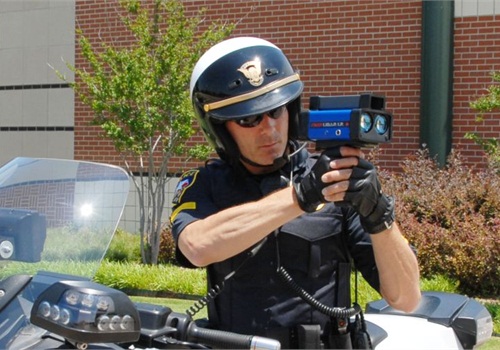
Police officer shooting laser
Police Laser Gun Overview
Unlike police radar guns which send a big blast of radar waves down the road that anyone running a radar detector can easily pick up on ahead of time, police laser (or lidar) guns send a pinpoint beam of light that’s specifically aimed at just one vehicle at a time. This has the advantage of making it easier for the officer to tell which vehicle he is getting a speed reading from as well as not providing advanced warning to oncoming drivers running countermeasures like radar detectors.

Police laser gun pinpointing a specific vehicle
The laser beam is very narrow (typically a mere 18″ wide at 500 ft away) which makes it easy for police officers to target a specific vehicle and quickly identify which vehicle is producing the number on screen. This is especially useful in heavy traffic when lots of cars are around.
Because the laser beam is so narrow and thin, radar detector users typically won’t get any advanced warning before they’re targeted. An officer could be targeting the car next to you, ahead of you, or behind you, and your radar detector’s laser detector won’t be able to pick it up. Heck, it’s even possible for you to get targeted and your radar detector’s laser sensor may not see it at all. Even if it does, by the time your radar detector goes off, it’s little more than a ticket notifier.
Let’s take a little closer look at how these police laser guns work.
Note: Laser and lidar are used interchangeably. Lidar stands for Light Detection And Ranging.
Tour of a police laser gun
Would you like to see a police laser gun in action and see what the police officer sees?
Here’s a quick look at one popular laser gun, the LTI TruSpeed S.
Want to see laser guns in action?
Next here’s the TSS being used to issue tickets. First up is a vehicle behind me that gets nailed for speeding. You’ll notice that my radar detector (Valentine 1) and laser jammer (Blinder HP-905) never goes off, even with the LEO shooting right over my shoulder.
and here’s a second encounter with me getting shot with laser from behind. I found an officer marked on Waze and wanted to watch him in action to see how he worked. When he finished writing one ticket and got set up to continue clocking vehicles, I drove past him. While driving, I accidentally missed a shift and instead of going from 2nd to 3rd gear, I went from 2nd down to 1st and inadvertently revved my engine as I passed. Whoops! He definitely noticed this, turned towards me, and shot me from behind to see if I was going to speed away. My laser jammers (AntiLaser Priority) went off instantly and I quickly killed my jammers to let him get a speed reading on my car. My radar detector (LRD950) never went off.
Usually police officers will shoot laser from a handheld laser gun like this and chase you down themselves to give you a ticket.
Other times they’ll be set up somewhere shooting and someone else will be issuing the ticket. There may be some chase cars up the road ahead and the officer will radio in to vehicles up the road and they’ll make the stop instead. Another option is that there could be a camera hooked up to the lidar gun and instead of making a stop in the first place, the police department will simply send a ticket in the mail.
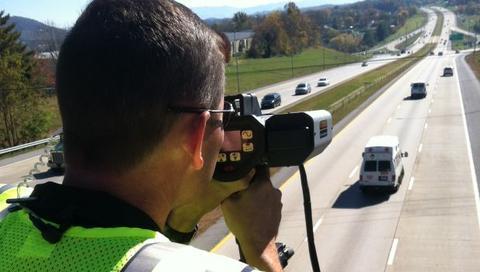
Handheld laser gun with a camera attached to the side
Here’s a quick look at how this looks from the driver’s point of view. This was up in Edmonton, Alberta. My radar detector (Stinger VIP) alerted me to a known speed trap where police commonly hang out and when I got shot from behind, my laser jammers (AntiLaser Priority) went off from behind and again I immediately killed my jammers to let him get a speed reading. (If you’re wondering why I’m killing my jammers, something that’s very important to do, read this.)
As you can see, laser is commonly used to target both the front and rear of vehicles (front is typically far more common) and police officers love using it in areas with higher levels of traffic
How do police laser guns calculate your speed?
So how do these lidar guns work?
Well if you look at the business end of a lidar gun, you’ll see two lenses. Behind one lens is an infrared (not visible light) laser transmitter and behind the other lens is a laser receiver that detects the laser beam’s reflections coming back.

Lasers use light and we know the speed of light (roughly 186,000 miles per second). When we send a quick pulse of light out, it will travel from the lidar gun, to the target vehicle, and back. If we measure how much time it takes to get a reflection (time of flight), we can calculate how far the light had to travel. Because the laser beam had to make a round trip to the car and back, if we divide that number by two, we’ll get the distance between the lidar gun and the target vehicle. That’s step one.
Now one pulse will give us distance (not speed), but if we shoot a whole series of pulses, we can determine the change in distance over time which will tell us the vehicle’s speed. (Speed is simply a measure of distance divided by time, ie. feet/second or miles/hour).
If it’s a little confusing to understand by reading, here’s a video where I explain this visually and go into more detail.
In short, the lidar gun is sending out a constant series of pulses, waiting for the reflections, and with a little math it can determine a vehicle’s speed, distance, and direction of travel.
What areas of a vehicle do police officers target?
Laser guns require a reflective target to get a reading off of so police have several primary targets that they aim for when clocking moving vehicles. These include:
- Headlights / tail lights
- Grill
- License plate

Those are shiny and reflective targets that make it easy for a laser gun to get a speed reading.
Modern laser guns can get a reading off of most anywhere on the car including your bumper, body panels, and so on, but police will generally target the most reflective targets.
What are the differences between radar and laser?
Police laser is different than police radar. Here’s some of the main ways that laser is different than radar:
- Police officer must be stationary when using laser. With radar they can be stationary or moving.
- Laser makes it easy to pinpoint a specific vehicle in traffic.
- Laser guns must be held up to the eye so the officer can aim.
- Laser doesn’t provide radar detector users with advanced warning.
- Laser is effective against radar detectors.
- Laser can be jammed by laser jammers.
What do handheld laser guns look like?
Laser guns come in several different form factors. Here in the US you’ll almost always encounter handheld guns, typically shaped sort of like a pistol.
Here is the Kustom ProLaser III, the most common police laser gun in use in the US.

You’ll notice that with the PL3, the lenses are set up in a side-by-side configuration. Other laser guns are designed with the lenses stacked on top of one another such as the LTI TruSpeed.

Some older guns like the Kustom ProLaser II had one lens actually inside of the other, but this is an older design that’s not really used anymore.
Some laser guns are shaped less like a gun and more like a set of binoculars. The LTI TruSpeed S is a good example.
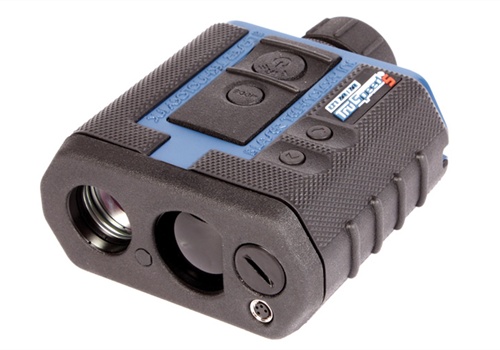
As with all handheld police laser units, they need to be held up to the eye to be used, allowing the officer to look through the viewfinder and place the crosshair directly onto the desired target.
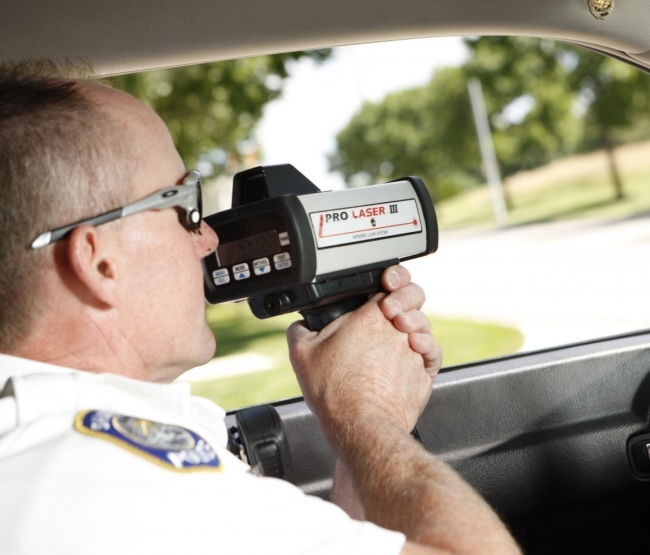
What do photo laser guns look like?
Photo laser is a little different. It’s basically a police laser gun integrated with a camera and instead of chasing down a speeder, an officer will take a photo and mail the vehicle owner a ticket. Let’s take a look at what photo laser guns look like.
The easiest way of doing photo laser is to simply combine an existing laser gun and camera and put them together such as with the Kustom LaserWitness Lite.

This can be a bit bulky so laser gun manufacturers also offer cameras built directly into the laser guns for a more compact setup such as in the LTI TruCam.
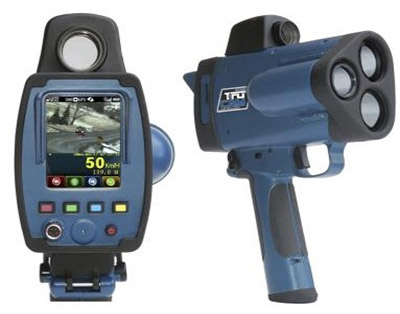
There are also some unmanned photo laser setups available too. Since you don’t have a person actually aiming the laser guns at specific vehicles, they are set up in a way where they can scan multiple lanes of traffic automatically. Here’s an example with the Poliscan.
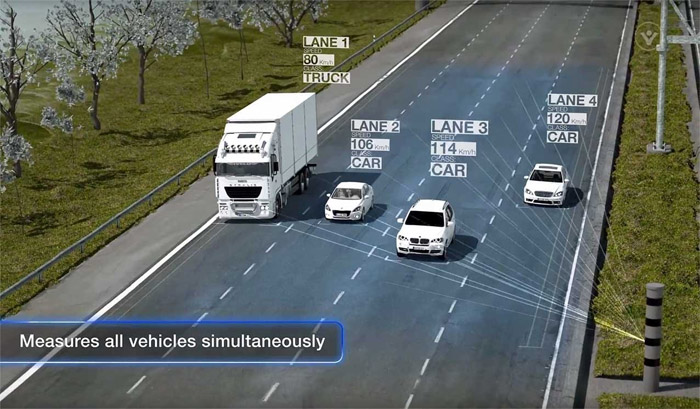
You’ll notice in that photo, the laser gun is installed in a pole along the side of the road. This is a fixed photo lidar setup.
They also have mobile photo lidar setups that can either be set up on the side of the road or installed inside a vehicle parked next to the road.
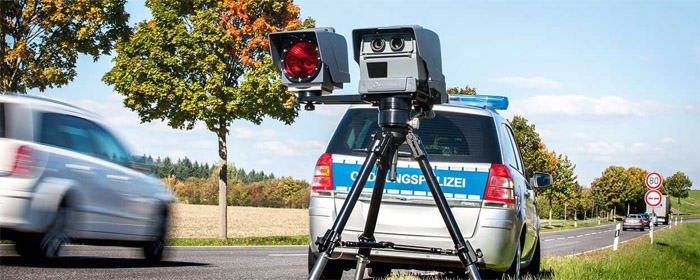
Photo laser is much more common abroad. Here in the US it’s mostly handheld laser that you’ll see in practice. There is some manned photo laser and even less unmanned photo laser here, but the vast majority is normal handheld laser.
How accurate is laser?
Because laser guns are being used to issue speeding tickets and their readings have to hold up in the court of law, they have to be accurate. Police laser guns are generally accurate down to +/- 1 mph or +/- 2 km/h.
In order to ensure that the gun has a good lock, it has to get a bunch of return pulses that all make sense. Getting just 2 or 3 pulses isn’t enough. Laser guns typically take about 0.3 sec to get a lock on a vehicle and for an example laser gun that fires 200 pulses per second, this means it needs 60 return pulses to get a reading.
As a vehicle moves towards or away from the gun, the distances should all make sense… something like 1000 feet, 999, 998, 997, 996, and so on. It’s only with a smooth set of distances like this that the gun can ensure that it’s locked onto a single target, it has a clean lock, and so on.
How do laser jammers work?
Modern laser jammers actually exploit this requirement. What they do is when they detect that a police laser gun is firing at them, they send back their own laser pulses that make absolutely no sense to the gun. What the laser gun will see is distances that look like 1000 feet, 350.2, 26.4, 125.7, 553.8, 300.1, etc. A laser gun looks like that and has no idea what to make of it, so it displays no speed and continues to fire, waiting for a series of return pulses that make sense.
For more information about laser jammers, watch my videos on how smart laser jammers work and how brute force laser jammers work.
How far away does laser work?
How far away can a laser gun acquire a speed? It depends on a variety of factors such as the design of the specific gun, how large the target vehicle is, and even how stable the police officer is (if they’ve got more handshake or they’re shooting in the wind, it can be tougher to keep a solid lock on a small vehicle farther away).

If you look through manufacturer spec sheets, you’ll typically see maximum distances listed on the order of 2,000 – 6,000 feet or so.
However, in some areas, there’s actually laws regarding how far away officers are legally allowed to shoot, independent of what the gun is capable of. Sometimes they have to shoot within 1,500 feet or less, for example. One reason for this has to do with beam divergence.
You see, the laser beam actually starts to widen (diverge) as it travels through space. It doesn’t stay a tiny, fixed dot forever.

The exact amount that the beam diverges varies from gun to gun, but a beam divergence of around 3 milliradians is pretty common. This means that 500 feet away, the laser beam will be 18″ wide (US license plates are 12″ wide). 1,000 feet away, the beam is 36″ wide. 2,000 feet away, the beam is 72″ (6 feet) wide.
If you start shooting too far, you increase the likelihood of thinking you’re targeting one car but actually getting readings off of the car next to it. This is why some police departments limit the maximum range that officers are allowed to shoot. They want to ensure that when an officer says they got a reading on a particular car, there’s no concern that they inadvertently got a reading off of a different car.
Not only that, but as you go farther away, the target gets smaller, handshake gets magnified, and sometimes the crosshair itself will actually completely obscure the little speck of a vehicle at a distance. Magnified viewfinders and tripods / leaning against a vehicle can help, but there’s still practical limits. While it is possible to get readings off of vehicles thousands of feet away, and bigger vehicles make this easier, laser is generally something you’ll see at closer distances.
Does poor weather affect laser guns?
How does rain or snow impact the laser gun’s ability to get a speed reading? With all the extra precipitation in the air blocking or even reflecting the laser beam, it can be more challenging for a laser gun to get a reading. It’s for this reading that many laser guns actually have a poor weather mode.
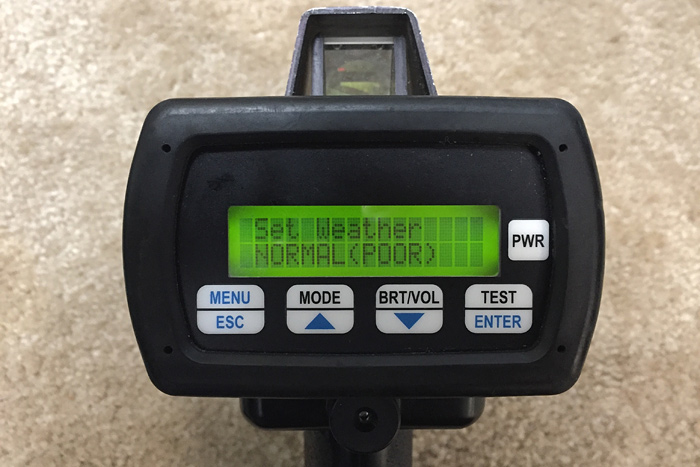
What that does is reduce the minimum range that the gun can get a reading from so that it ignores any very close readings (ie. a big fat rain drop a few feet away from the gun). For example, when set to poor weather mode, the laser gun may require the vehicle to be 200 feet away or more in order to be able to be measured. This ensures that the laser gun is only measuring targets beyond the range of where rain and snow can affect the laser’s ability to capture a speed reading.
Laser can also be operated within a vehicle and shot through a window or windshield so yes, even if it’s raining out, police can still user laser.
Are some vehicles harder to clock with laser?
People often ask if some vehicles are harder to get a reading off of than others. Are black cars harder to get a reading from because they’re less reflective, for example?
Modern lidar guns are really good at getting a lock on a vehicle. Any vehicle. Even motorcycles. Older guns used to struggle with this more, but modern guns have no issue getting a lock on cars, particularly at close range which is how laser guns are designed to be used. That said, some vehicles are a little easier or harder than others.
Vehicle type
Some of the toughest cars to get a reading on would be low profile sports cars. Big SUV’s and vans are much easier to get a reading off of, especially at a distance when the target is smaller. You can probably guess why. When you have a big target, it’s easier for a lidar gun to get a reading. Sports cars usually have a smaller wedge-shape up front for improved aerodynamics and so the smaller target area can make it tougher to get a lock on the vehicle, especially at a distance, and so it may take a little bit longer to get a reading off of some vehicles than others, but the gun can definitely still do it.
Front vs. Rear
It’s normally easier to get a lock on the rear of a vehicle. The front is usually angled and more wedge-shaped to minimize wind resistance while the back is usually pretty flat and perpendicular. The large perpendicular rear of a vehicle is easier to get a speed reading from than the front. Plus everyone has (reflective) license plates in the rear while front plates are only required by some states.
Vehicle color
Paint color doesn’t make a big difference to laser guns, not anymore anyway. Whether the vehicle is black, white, or silver, a laser gun will be able to get a reading off of the car.
How to Defeat Police Laser?
As drivers, we may want to have defenses to protect us from laser guns. I recommend having multiple layers of protection to help swing the odds into your favor. What are the different options available, both effective and ineffective, and how well do they work?
Radar detectors
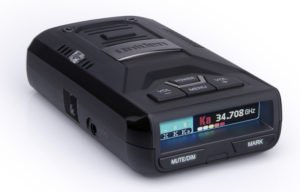 Radar detectors have laser detectors built into them so they can alert you to laser up ahead, but in practice they’re nearly useless. Against police radar, sure you’ll get advanced warning and they’re great for that. Laser is a different animal and you generally won’t get advanced warning against laser guns.
Radar detectors have laser detectors built into them so they can alert you to laser up ahead, but in practice they’re nearly useless. Against police radar, sure you’ll get advanced warning and they’re great for that. Laser is a different animal and you generally won’t get advanced warning against laser guns.
With laser, your radar detector will typically only go off when the officer is targeting you and by then it’s too late. By the time it goes off, he’s got your speed and your radar detector is little more than a ticket notifier. Great… Heck, often times you can get shot and your radar detector won’t even go off at all. That’s super common too. With laser being such a thin beam, since your radar detector is installed up on your windshield and he’s aiming down at your grill somewhere, the radar detector is too far away to even see the beam.
Some people may want to run their radar detector low on their windshield to help increase the odds of detecting laser, but this will diminish radar detection performance and again, even if your radar detector does go off, he’s already got your speed anyway so that really won’t help much.
Now it is possible to sometimes get advanced warning against laser, especially with a very sensitive laser detector in your radar detector. The laser beam can bounce and reflect off of a vehicle that’s getting shot ahead of you and you can get alerted before you’re the one being clocked. This is known as “scatter,” but it is extremely rare and is in no way a reliable way to protect yourself from speeding tickets. There’s better solutions available than a radar laser detector.
Laser jammers
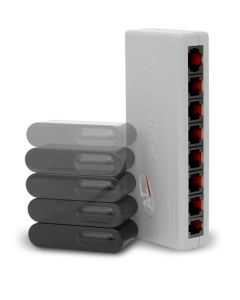 Laser jammers are the best tool you have to combat laser. They are specially designed devices installed in the grill area of your car that not only detect laser like a radar detector, but they also fire back and jam the laser gun, preventing it from getting a reading. When you get shot, the alarms start going off in your car, you slow down to the speed limit, kill your jammers, and let them get a reading off of your car, and you go on your merry way.
Laser jammers are the best tool you have to combat laser. They are specially designed devices installed in the grill area of your car that not only detect laser like a radar detector, but they also fire back and jam the laser gun, preventing it from getting a reading. When you get shot, the alarms start going off in your car, you slow down to the speed limit, kill your jammers, and let them get a reading off of your car, and you go on your merry way.
There are a number of different laser jammers available. However, the best and most effective laser jammer on the market is the AntiLaser Priority. You can read my review of the ALP here.
Laser jammers do need to be installed properly in order to be effective. Many people actually do it wrong and wind up installing them in a way where they can’t provide adequate protection. It’s for this reason that I’ve put together a comprehensive laser jammer setup guide to help walk you through the process so that you can avoid all the common mistakes and have an effective laser jammer setup.
People often ask about the legality of laser jammers as well. Laws vary from state to state, so check out my article on laser jammer laws if you’re curious.
Laser scramblers
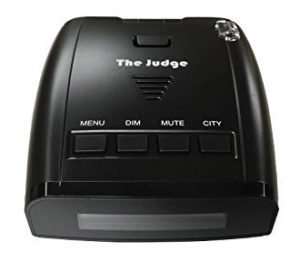 There’s a company called Rocky Mountain Radar which sells radar detectors with a unique feature they call “scrambling” which is essentially a passive jammer. It functions different than a traditional jammer, but it actually doesn’t work at all. RMR is considered to be one of the biggest scammers in the industry and they prey upon innocent customers by advertising a bunch of nonsensical technobabble to try and confuse people, but in reality their products are snake oil.
There’s a company called Rocky Mountain Radar which sells radar detectors with a unique feature they call “scrambling” which is essentially a passive jammer. It functions different than a traditional jammer, but it actually doesn’t work at all. RMR is considered to be one of the biggest scammers in the industry and they prey upon innocent customers by advertising a bunch of nonsensical technobabble to try and confuse people, but in reality their products are snake oil.
If you’d like to see for yourself, I’ve tested the RMR C495 against different police lidar guns, I’ve tested the RMR Judge against police lidar guns, and I’ve put the RMR on an oscilloscope alongside a laser gun and an actual jammer to show the difference between how they operate (the RMR doesn’t actually emit anything).
The “scrambling” functionality is nonsense and the company isn’t being honest with you. Stay away.
Veil laser absorbing paint
Speaking of passive laser protection, another option is Veil. It’s a laser absorbing paint that you apply to the reflective areas of your vehicle including your headlights, fog lights, and license plate if applicable. The idea is it absorbs laser, preventing the laser gun from getting a reading for a few seconds, long enough for your radar detector alert (assuming it does) and you can slow down before he gets a reading. Good idea, but unfortunately it has a number of serious issues, even besides the fact that it isn’t effective.

The previous generation of Veil (G4) had issues with cracking people’s headlights. Veil changed their formula with G5, but it was so dark that you’d have bigger issues than dealing with laser guns. If you look at the photo above, the problem is obvious.
The formula has been changed yet again to make it lighter, but unfortunately that doesn’t change the fact that Veil simply isn’t effective at preventing laser guns from getting a reading. You can take a look through several different independent tests (Veil Test A, Veil Test B) and you’ll see for yourself. I’ve run both the old version and the new version in the past before and, well, I definitely don’t run it anymore.
Against areas of your car where Veil is applied, laser guns can get a reading. Even it could block laser guns, against the parts of your car where Veil can’t be applied, such as your bumper or body panels, laser guns can get a reading too… so even if it did work, there’s still some big problems with the product that formula changes won’t resolve.
I’m all about having several different layers of protection to all complement one another. Veil is less than $100 so it’s not a lot of money, but unfortunately it’s nevertheless a poor investment. Not recommended.
License plate covers
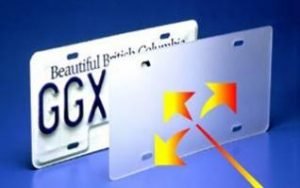
Another option to help keep you protected is to put a laser diffusing license plate cover over your vehicle’s license plate. The idea is that even if it’s not going to fully protect you from laser guns, every little bit helps, right?
I’ve had a chance to test these out twice before and found that laser guns are still able to get a reading off of a license plate covered with these covers.
Not recommended.
Waze
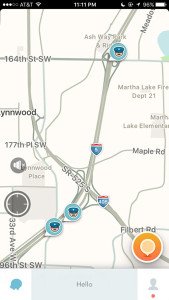 The last thing I’m going to talk about is something I actually do recommend, running a cloud-based alert sharing app like Waze. Waze is a free GPS navigation app like Google Maps, but the killer feature is that it allows you to report where police officers are as you drive. See an officer set up on the side of the road running laser? Mark him in Waze and alert everyone else running the app. They’ll do the same for you in return and so everyone wins.
The last thing I’m going to talk about is something I actually do recommend, running a cloud-based alert sharing app like Waze. Waze is a free GPS navigation app like Google Maps, but the killer feature is that it allows you to report where police officers are as you drive. See an officer set up on the side of the road running laser? Mark him in Waze and alert everyone else running the app. They’ll do the same for you in return and so everyone wins.
Since police officers have be stationary when running laser, unlike when they’re using radar, Waze is an excellent countermeasure for laser.
It’s certainly not a replacement for laser jammers. Rather, it’s a complement to it.
If an officer just arrived and hasn’t been marked in the app yet, if it’s dark at night and no one can see him, or for some reason he’s not in the app yet, your laser jammers will provide you with the save.
If he’s marked on Waze but you’re only running laser jammers up front and he shoots you from behind, your laser jammers won’t help but Waze will save you.
There’s also times with both of them will protect you, so it’s all about having multiple effective layers complementing one another to help you improve your odds.
Escort Live
Finally, there’s another app called Escort Live which is very similar to Waze, except that it’s designed to integrate with Escort radar detectors. The idea is that when an Escort radar detector gets a legitimate radar or laser alert, it will post that to the cloud automatically (unlike Waze where you have to report police spotted manually) and every driver in the area can benefit.
Personally I find that Waze has the edge in alerting simply due to the fact that it has way more users reporting information, but both apps can help so you can run one or both apps backgrounded and hear the audio alerts through your phone when they are present.
If you have an Escort Live compatible Escort radar detector like the iX, Max360, or Redline EX, those Live alerts can pop up on the face of your detector so you don’t have to pay attention to your phone, a nice little advantage.

Escort Redline EX alerting to Ka and Laser alerts ahead via Escort Live
Conclusion
Police laser guns are an effective and deadly tool that police officers can use to issue speeding tickets. Learning a little bit about how they work will provide you with more understanding regarding what you’re up against and how to defeat it.
When properly equipped with the appropriate countermeasures including a good laser jammer and Waze, laser is really no big deal. Heck, grab a dashcam too and then you’ll be able to share videos all the fun laser encounters that you experience out on the road.
Happy driving and drive safely out there!
| This website contains affiliate links and I sometimes make commissions on purchases. All opinions are my own. I don’t do paid or sponsored reviews. Click here to read my affiliate disclosure. |


27 comments
Skip to comment form
Hi, i love your videos ect, i live in australia own a motorbike and have had a bad run with laser radars and mobile speed cameras. Is there any setup that could be used with a bike both laser jamming and radar detection. I’m happy to permanently mount any equipment but weatherproofing would probably be an issue. Do you have any advise for someone in my situation as i find I’m spending more attention watching for radars than i am my own safety.
Author
You can mount a radar detector and laser jammer on your bike. People do that. As for recommendations, things are different there so here’s a good place to ask: https://www.rdforum.org/index.php?forums/104/
I had a laser/radar scrambler on my zx12r (top speed well over 200mph :p) just Google weatherproof ones.
Speed of light is not 186k mph. It’s very close to 186k miles per second though:p
Author
lol whoops! You’re right. Thanks for pointing out my mistake! Fixed. 🙂
Great article! But….there are some very important things you left out that I would like an answer to if possible 🙂
Jammers are highly illegal in the United States, so question number one is, do Police KNOW that you have a jammer when they get a scrambled signal back?
If so is it just because of the scrambled signal or do they have a jammer detector? In the United States they can actually arrest you and put you in jail for using one so that’s very important to know!!!
And the second question is something I’m confused about. Do you have to turn the jammer off and slow down in order for it to work? What if you’re not paying attention or listening to the stereo and you don’t react in time and are unable to turn it off fast enough?
I mean you are talking about a pretty fast reaction time here right? This guy is pointing a laser at you and within a couple seconds you have to be able to react immediately and fast enough to turn it off and adjust your speed.
So who cares if you failed to do all that because they can’t get your speed anyway right?? Thanks!!!
Author
No you can not be jailed for having a laser jammer. You might be thinking of radar jammers. Here is the information on the laws regarding laser jammers: https://www.vortexradar.com/2017/11/are-laser-jammers-illegal-or-legal-in-the-usa-laser-jammer-laws/
If you leave your jammers on indefinitely, yes it will be pretty obvious you have them. However, if you quickly disable them, most officers will have no idea. It’s not uncommon for it to take a little longer to get a lock onto certain vehicles for a variety of reasons. When the jammers go off, the lights and alarms go off in your vehicle so it’s very obvious, you can have it automatically lower the volume to your stereo if you like, you slow down, and you press a button or let them disarm automatically. 2-3 seconds is a pretty good amount of time.
??? You just used as proof an article that listed 12 states where it’s illegal!!! Maybe my term theUnited States was a bit broad but I was trying to simply say that in some areas it is considered illegal. I am not sure why you think or believe that you cannot be arrested and go to JAIL for ANYTHING it is illegal!!! Any traffic violation is a criminal statute in which one can be arrested.
So I will freely admit that I used broad terminology by saying the United States and not areas of, but you have just committed that exact same offense by boldly stating that you cannot be arrested for using a laser jammer while saying it’s illegal in 12 states!!!
Yes sir, you absolutely, unequivocally, can be arrested and taken to jail for using a laser jammer, not a radar, and if you like, I’ll be more than glad to post some links to prove that point where individuals were indeed arrested!
Honestly I’m not sure why you are stating it’s illegal in 12 states on one hand, but that you cannot be arrested on the other?? Not trying to give you a hard time but that statement took me back a few steps because you are trying to reassure the general public that that situation can never take place and that is simply not true!
A quick Google search will reaffirm what I have said and in fact I’ll post one here 🙂
“A man received a suspended jail sentence, a driving ban and hefty fine for using a speed camera jammer device on his car. … The operator had previously attended a Road Safety Support advanced course in laser speedmeter operations, and was qualified to recognise when laser jammers were in use. Nov 2, 2017”
Author
Links to something concrete would indeed be helpful. I’ve never heard a single person in the US being arrested yet. Abroad it’s different, but the penalties in the US are very minimal. You may know something that I don’t and I’d always love to learn more if you have something helpful to share.
I was not trying to embarrass or argue or otherwise get into a big deal with it 🙂 but posting links is a moot point because in America if something is illegal, we can be arrested for it, that pretty much goes hand-in-hand and is a given 🙂
So since we know it’s illegal in 12 different states, that automatically equates to meaning at any time you can be arrested and go to jail for the offense, as such links are not needed, no more so than to post links showing that people can be arrested for shoplifting or drinking underage or any of the other various minor illegal offenses!
Surely everyone has the capability of punching in “people who were arrested using laser jammers” on Google and I’m sure it will provide any and all information that the user would seek 🙂 Not to mention I already posted one!
Even if by some miracle of God let’s say that no one had been arrested to date, that still does NOT mean that one cannot be arrested in the future, as again if it is illegal it is illegal and any illegal offense one can be arrested and jailed, even if it’s not considered the norm 🙂
Hi,
Our Greater Vancouver Police are using the LTI TruSpeed S. Does this have stray beams? Can the Radar Detectors detect its stay beams? Or will its beam reflected and/or refracted? So, the following and/or other vehicles in the vicinity can detect it by their detector?
I’m thinking to purchase the Uniden R1 or R3, based on your testing and reviews. Can these detect the LT1 and any other recent radars, like the ones that mimics the Blind-spot radar system and the ones in Alberta?
Do you know if they update their Radar Database regularly? If not, what is the next and closest Radar detector to these ones?
I live and drive mostly in the Greater Vancouver area and run Waze on my phone. Would the R1 be sufficed for my application?
Are there any used Antilaser Priority since I’m on a budget?
Author
I’m not sure what a stray beam is. The TSS shoots a very tight beam and you’ll need a laser jammer to properly defend against it. Radar detectors are great for radar, but they need to be paired with a laser jammer for help combat laser.
You can occasionally find ALP’s for sale used, but it’s not that often.
Hey Bro!!! ive been a follower of you for quite a few years now, and ive gotten numerous detectors (to be exact, 1. Beltronics RX65, 2. Escort Reline, 3. Escort Passport max 2, and 4. Uniden R3) based on your extensive reviews and recommendations! I really appreciate your channel and all the help you give out to the community, and i was wondering if you could help me out… Im fighting a speeding ticket here in California that was issued based on LIDAR… i have a decent case built up, but i was wondering if you knew which brand of LIDAR CHP uses here in California!!!
Thanks so much
-ahmed
What if any complications are there from using a laser (Lidar) detector at night. Do headlights and glare create a situation where target acquisition is impaired?
Author
Nope. If anything, night time makes it easier for laser guns as the bright headlights present a big bright target for officers to aim at.
illegal and being arrested are different. In my state it is illegal to spit on the sidewalk but you are not arrested for it. It is illegal to drive 34 m.p.h on residential roads and you might get a ticket, but arrested? No. However, murder is illegal and will get you arrested.
Recently I was stopped for speeding and I was not speeding, I did however hit the pedal hard enough to get around an improperly covered work truck spewing rocks, shells and whatnot, and this got the officers attention. Heard no radar alert, no laser laert, just the officer.
I have a blue lives matter plate cover that had no effect on this officer, but what I did have was a Blackvue dashcam. The officer said I was speeding, I said your incorrect and I can prove it. I simply pulled the chip, put it in my phone, played the last two minutes of me driving, which showed my exact speeds. He said that’s a first and told me have a good day. I may nor may not have been speeding before my encounter with this officer, but that’s neither here nor there. 😉
Author
Wow, glad to hear your dashcam was able to assist you on the spot like that!
Hello, Vortex,
great article which helped to understand laser vs. radar better. Recently we got a number of new mobile laser speed cameras in our country (Europe). Actually they are the same as in the picture in your article (on a tripod, with the POLIZEI Opel Zefira behind it). In Europe currently its more popular to use stationary, mobile-automatic and average speed cameras and undercover cars with radars rather than “speed guns”. So now Im thinking: what if you use a laser jammer mentioned in your article against this automatic speed detection system – the police officer will not even see that I am jamming his signal since he is sitting in a parked car eating a donut? Do these laser jammers work as effectively against these stationary laser speed cameras as they work against “speed guns”?
Thank you for your time to answer 🙂
Author
Hey Andrius, yeah laser is laser so whether it’s being shot from a handheld gun or from a fixed unit on a tripod, the laser jammer treats it the same. There’s different technologies used in different laser guns of course so you’ll want to choose a laser jammer specifically designed for the guns used in your country.
Can a laser gun ,detect the color of your vehicle ? I got a ticket the other day in my black truck . On the ticket he wrote it was grey . Just curious .
Author
They don’t. That’s what the officer wrote based on what he saw himself.
Hi I follow you on youtube since quite some time,
I got my first radar detector Uniden r3 and it works great however I get a lot of laser alarms and the officers don’t shoot stationary they actually move.
You say that they need to be stationary but evidently something changed can you follow up on that on youtube??? Would be appreciated
Author
Laser can ONLY be used when stationary. That hasn’t changed. There are some sources of false laser alerts that are not police officers. See this video for more info: https://youtu.be/ghafcsCHd7w
Is it possible to design a HID headlight that includes 904nm in order to blind Lidar?
Can laser detect the speed of multiple cars at the same time? I was pulled over and the officer said “your group, the three of you were going 94mph”. I was not in a group nor was I going 94 mph. How can I fight this ticket?
Author
Laser is designed to pick off individual cars, one at a time. It’s possible he tagged each car individually, one after another. I can’t say for sure. Either way, speaking with a lawyer would be your best bet. If you have a dashcam, you can share that footage with your lawyer too.